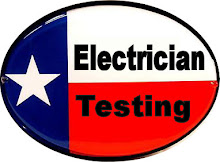Wire Ampacity and Conduit Fill Calculation
This week I want to take a minute to review our wire ampacity and conduit fill (wire fill) calculation.
There seems to be a lot of common confusion out there when it comes to wire fill. Annex "C" in the back of the 2008 NEC © is a good tool, but it can be very dangerous to use it without considering the impact of de-rating factors found in Chapter 3.
We normally use a 20 amp circuit breaker to protect #12 AWG cu wire. Annex C tables show that we can safely place a total of 16 of this size (Type THHN, THWN, or THWN-2) in a 3/4" EMT conduit. this is only for the protection of the wire from a physical stand point.
Annex C is only concerned with the protection of the wire during installation. It does NOT take the ampacity of the wire into consideration!
When de-rating wire, we begin with table 310.16 (page 147, 2008 NEC ©) and de-rate for our ambient temperature AS WELL AS the number of current carrying conductors. The de-rating table T310.15(b)(2)(a) on page 145 shows us:
"Adjustment Factors for more than Three Current carrying conductors in a Raceway or Cable"
Number of Current Carrying Conductors
% of 310.16 Values
| 4-6 Conductors | 80% |
| 7-9 Conductors | 70% |
| 10-20 Conductors | 50% |
| 21-30 Conductors | 45% |
| 31-40 Conductors | 40% |
| 41+ Conductors | 35% |
You can quickly see that in our earlier example, if we put 16, #12 THHN conductors in that 3/4" conduit, we would have to drop the circuit breaker to a 15 ampere size!
Now seriously, how many electricians in the field really do that? You understand now how dangerous the casual use of Annex "C" can be.

For all practical purposes, only 9 current carrying conductors could be placed in that conduit without having to drop the OCPD (circuit breaker) size: [T310.16 value for #12 THHW=25 Amps. 25 Amps X 70% (the de-rating for 7-9 conductors) would equal 17.5 Amps, and due to 240.3(B) we are allowed to round up to a 20A breaker.] The Cut Off point is the 10-20 conductor line that HALVES our breaker/fuse sizing.
Neutrals CAN count as Current Carrying Conductors:
The grounded conductor (neutral) can also cause confusion sometimes. It counts as a "current carrying conductor" in some cases, but not in others. If it is shared between two different phases in a multi-wire circuit, it usually does not count as a current carrier , as it only carries the unbalanced load in the circuit. [For example, a "full boat with circuits #3, #5, #7 in a 30 panel, would not usually have their neutral counted.]
Where non-linear loads are supplied however the neutrals DO count. If you have electronic fluorescent ballasts or heavy computer loads (etc...) on a shared branch circuit neutral, it will have harmonic distortions that will disrupt the cancellation of loads between phases and can actually cause larger loads on a neutral that are found on any single ungrounded phase conductor in the circuit.
If the (neutral) grounded conductor is NOT shared between phases, i.e. a single 120V single phase branch circuit, such as a general purpose receptacle outlet circuit conductor, it counts as a current carrying conductor. In this installation it carries the full load of the circuit back to the distribution point.
Two other common issues with Annex C are considerations for different sized EGC/GEC conductors, and differences between Annex C values and manual fill calculations using Chapter 9, tables 4 and 5.
The value of Annex C is a "stuff it full" value. Therefore you would have to keep in mind your additional ground wire, which is usually a smaller size than that of the phase conductors. The only way to use Annex C in this case is to always consider your EGC or GEC as a full size conductor count. A manual calculation is more accurate than Annex C and it has been this author's observation that Annex C values sometimes vary quite a bit from a manually calculated fill based on Chapter 9 tables.
All of that considered, going back to our 3/4" raceway, we could put 3 "full boats" in this raceway (3 neutrals not counted, 9 phase conductors, and 1 equipment ground) for a total of 13 conductors. This results in 3 less than our "fill amount" according to our Annex C tables. Thus, our advice is to always carefully consider your ampacity de-rating factors as required by 310.15.
(Author's Note: As evidenced by the above, an electrician would have to refer to several different tables in order to correctly and safely calculate the correct fill and ampacity values for watch and every pipe run. we are excited to provide and industry first for all our members. Electrician Testing has painstakingly prepared a custom table; available only through us, that considers ALL required factors. Everything is brought together in one quick and easy to follow chart. Contact us today to get yours, and look for our upcoming publication that will include this chart along with many, many more custom time saving tables!)
Mitchell Tolbert
Master Electrician


